Archive for the ‘Chinese Folk Arts’ Category
Folk Arts and Festivities-Chinese New Year
Chinese New Year, also known as the Spring Festival, is the biggest holiday in China. Recorded in Li Ji – Yue Ling, Chinese New Year is the time when “air pressure of the sky comes down and air pressure of earth goes up. When heaven and earth connects, all things geminate.” This summarizes the main features of folk art works on Chinese New year, which are heaven and earth, yin and yang, propagation and harvest.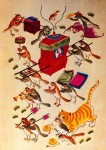
Chinese New Year window decoration usually bears the same implication as for wedding ceremonies. The best I have seen is the paper-cut on the cave windows on the loess plateau. On New Year’s Eve, people put on brand new white window liner. Above the crossbar of the cave window is considered the sky. On the center of the crossbar is a large ball flower of “Baby with coiled hair holding a pair of fish,” a “Revolving flower ” indicating that life revolves around the sky. Below the crossbar is the 36 window lattice. A totem animal (a tiger or a deer) takes the middle four lattice, and other window decorations fill the rest to form a diamond square design with end flowers on four corners. It is similar to the “Thirty-six window lattice of clouds” on wedding occasions, or the “Eight diagram window.” Themes of those paper-cuts include “Two dragons playing with a ball,” “Two phoenixes playing around a peony;” “A golden clock over a frog;” “A deer and a crane;” “A snake twining round a rabbit;” “A vulture catching a rabbit;” “A dragon, a tiger and a vulture;” “Lion playing with a silk ball;” “A rooster holding a fish in the mouth;” “A rat bit open the sky;” “A bowl of Pomegranate;” “Buckled bowl in the shape of two frogs;” or of two fish, two tigers or two rats, “Fairy fish vase;” “Paired tiger vase;” “The Eight diagram fish;” “Deer head” etc. There are also a variety of paper-cuts with the theme of life and propagation: “A snake twining round nine eggs;” “treasure toad;” “A pair of toad;” “frog carrying a rock.” It is a colorful picture of a legendary animal kingdom with birds flying, fish jumping, people laughing and horse soaring. Inside the cave, the kang is decorated with “Border flowers,” across the dish rack is a row of “Dish rack clouds,” and in the center of the ceiling is a large ball flower of “Phoenix playing around peony,” and on the lintel is “Baby holding hands” or “Baby of sun flower seed.”
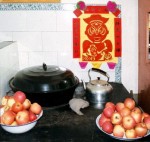 In Shandong, the lower stream of the Yellow River, it is a whole different taste. The main subject of Chinese New Year paper-cut is the flower of life which grows high from a water pot or a fish bowl. Paper-cuts of the flower of life in a water vase, or the tree of life in a water pot, are pasted across the lintel. Similar paper-cut is also popular in northern Suzhou, south of the Yellow River, all the way to the Yangtze River valley.
In Shandong, the lower stream of the Yellow River, it is a whole different taste. The main subject of Chinese New Year paper-cut is the flower of life which grows high from a water pot or a fish bowl. Paper-cuts of the flower of life in a water vase, or the tree of life in a water pot, are pasted across the lintel. Similar paper-cut is also popular in northern Suzhou, south of the Yellow River, all the way to the Yangtze River valley.
Nowadays urban residents like to paste Chinese New Year paper-cut letter “Fu” (good fortune) upside, as “fu dao” (good fortune arrives). Actually, the diamond square of upside down letter “Fu” was meant to be a rotating symbol for perpetual life.
In Inner-Mongolia, Chinese New Year door-god paper-cut is a pair of deer or a pair of roosters. In central Shaanxi, it is two tigers, and in Henan two monkeys, or cows, or two babies with coiled hair riding a golden cow. These paper-cuts are made with yellow glossy paper, a common way to pray for patronage from the totem or legendary animals for family safety and keeping away evil spirits and disasters.
Chinese New Year is the “beginning of a year, everything starts fresh and gay.”Every household changes a new woodcut of New Year picture. Polytheism that has been widely accepted by Chinese folks believes that every living creature has a power of its own. Such belief can be seen in some of the art works too. New Year picture featuring all types of gods are put out at Chinese New Year time for safeguard. On the 23rd of the twelfth lunar month is to worship the cooking stove, replacing a year old woodcut of “stove god” with a new one for the New Year. Pasted on the two door leaves are two famous warriors from the Tang dynasty, door god “Shentu” and “Yulei,” carrying reed ropes ready to kill any approaching demons. On the shrine by the door steps is god of land; in the yard are gods from ten directions; above the stove is god of wealth; and by the well is god of the well. In Yunnan, Yi and Bai ethnic groups culture has over 100 different images of gods for safeguard, each having a designated function.
7th of the first Lunar month is the “Human Day,” the day the rat, god of propagation, marring off a daughter. Women would hide their basket of needlework to avoid being bitten by the rat. Big paper-cut “Rat marrying off a daughter” can be seen on the wall in every household on the Human Day. Other areas where birds are worshipped, like Sichuan, it is the “Sparrow marring off a daughter.” The 15th of the first lunar month is the Lantern Festival. Every household folds paper lanterns in a square or a diagram shape, fully decorated with colorful paper-cuts. Types of the lanterns vary from geographically related legendary animals to geometry symbols of life and propagation, such as “The moon lantern;” “Baby with coiled hair lantern;” “The eight diagram lantern,” to name a few.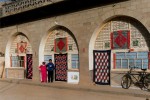
In the south of Yangtze River valley, between 1st-15th of the first lunar month, people have large gatherings to invite, dance for, and send off exorcists. It starts with going to an exorcist temple to request the mask of exorcist for a baptismal ritual. In Miao ethnic group area, it is the Chinese New Year outdoor gathering in the countryside, when young men and women in festival customs bearing embroidery totem animals and life symbols, playing music instrument (a toad shaped wind instrument), singing and dancing. Such festivity is actually a cultural extension from the ancient custom of worshipping heaven and earth at the suburb of the capital.
The Social Context of Folk Arts – Wedding Ceremonies
Traditional wedding is meant for the union of a male and a female, yin and title=”A large-scale “Happy baby” ball flower papercut yang, which lead to human propagation and perpetual life. The folk art works on custom wedding ceremony bear distinctive features on the theme. Fish, being a proliferous legendary animal, is often used to symbolize having multiple children. A yin-yang paired fish became a cultural code in Chinese folk art works.
At wedding ceremony, paper-cut “Fish playing around lotus,” “Fish biting lotus,” “Lotus bearing seeds” and “Happy dolls” (baby with coiled hair holding a pair of fish) are pasted on the ceiling of the bridal chamber. In northern Shaanxi, red or green paper-cutting of “Baby with coiled hair holding a pair of fish” in a big ball flower design is pasted on the center of the cave window. They are called “revolving flower,” as the revolving sky. The lower and middle part of the cave window is usually a lattice window in 36 counts. A large totem animal paper-cut (a tiger, a sheep or a deer) is over the middle four lattice; each corner lattice has a corner flower; the rest space are filled with colorful paper-cuts like “Buckled bowls,” “Paired fish,” “Fish playing around lotus,” “Lotus bearing babies,” “Rat eating pumpkins,” “Squirrel eating grape,” “Monkey eating peach,” “Rabbit eating cabbage,” “Golden pheasant visiting lotus flower” etc., making up a diamond square shaped “36 lattice window of clouds.” The colorful paper-cuttings against the white window paper liner definitely add a delightful atmosphere. In here, rat, squirrel, rabbit and golden pheasant are male; and lotus flower, pumpkin, grape, cabbage, peach are female. Putting animals and plants implies combining male and female for multiplication.
In the upper and middle reaches of the Yellow River, gift bread for wedding ceremony from the maternal family is a round bread made of two connecting fish, or a tiger head on a dragon body with a fish tail, with a world of living things plugged on the back. In Hua County, Shaanxi Province, the wedding bread is a “High rise bread platter” with a reed cylinder in the center as if connecting to the sky; and paired fish stuck on very layer from bottom up, such as a paired fish sharing one tiger head or a sheep head; a paired dragons with a tiger head; or a fish tail with a phoenix head. The top layer is a treasure bottle and a happy baby, a symbol of wealth and more children. At the wedding, two “High rise bread platters” are placed on each side of the table where the bride and the groom bow to the sky, to earth and to each other. It 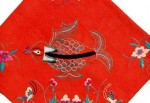 is quite a scene.
is quite a scene.
In Shaanxi, Shanxi and east of Gansu, a custom wedding embroidery is a hand made red undergarment, showing a fish (the bride) with an open cut on her body (a female uterus). It is part of the dowry as a gift from the bride to her groom. Other embroideries include male and female animals of proliferous nature; hanging ornaments of flowers and fruits; or a “Needle holder”, a “Needle toad”, as gifts for the female in-laws to show off bride’s craftsmanship. A custom in the monkey totem tribal culture in Henan is for the bride to embroider a male monkey, symbolic of her husband, and hide it at the bottom of the suitcase to take with her to the husband’s family on the wedding day. A secret porcelain “Happy baby,” with female coiled hair but a male body, is placed under the bed sheet on the wedding night. It is meant to be crushed during intercourse, a prayer for more children. Traditional porcelain “Happy baby” is still being made today at a porcelain cellar known for manufacturing the Song Dynasty porcelain in Yu county of Henan Province.
Social Context of Folk Arts – Birth
The carriers of folk art are folk social customs. The original philosophy and visual image based on folk art is the product of the Chinese community and has become ingrown in people’s social life. Its all time theme of life and propagation meets the needs in different aspects of life, displaying its beauty in a variety of colorful ways.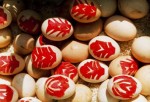 The “red egg” from the maternal family sent on the first full month of a new born, with papercut “evergreen tree” pasted on it, a folk custom along the Yangtze River.
The “red egg” from the maternal family sent on the first full month of a new born, with papercut “evergreen tree” pasted on it, a folk custom along the Yangtze River.
What is the theme of human birth? First it is to know where life comes from; and then to wish that the newborn grows up healthy and strong. Human life comes from mother’s body of the universe, which the Chinese believe is as primeval as pigeon eggs, and from mother’s body of totem animals. Therefore, it is customary to give chicken eggs, which are known as the “red egg” in Hunan in the Yangtze River valley. People also paste paper-cut “The tree of life” in bright red color on the red eggs as good-wish for the newborn. In the Yellow River basin where flour is a staple food, people make steamed bread, symbolizing the domed universe. Inside the bread are red beans implying that a new life has been conceived; “Wonton” steamed bread are made with two curly twists, implying the unification of yin-yang that creates life on earth. In Shanxi and Shaanxi, birth bread is called “Wonton,” or “Grain twist.”
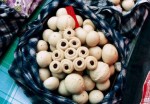 Human life comes from mother ’s body of totem animals, god of propagation. In areas where people worship legendary animals or totem animals like the turtle, the snake, the fish and the frog; and in places where supernatural power becomes personalized in “Baby with coiled hair;” birth presents from the maternal family are pillow case with patterns of a paired fish (yin-yang), or a paired turtles and a paired frogs. There are also embroidery patterns of “Crawling baby with coiled hair” (this is very similar to the design on the porcelain pillow from northern China in Song, Yuan, Ming and Qing dynasties.) It is interesting to note that a diamond shaped symbol like a female uterus is placed in the center among the animals, implying that the new baby comes from mother’s body of legendary animals or god of propagation.
Human life comes from mother ’s body of totem animals, god of propagation. In areas where people worship legendary animals or totem animals like the turtle, the snake, the fish and the frog; and in places where supernatural power becomes personalized in “Baby with coiled hair;” birth presents from the maternal family are pillow case with patterns of a paired fish (yin-yang), or a paired turtles and a paired frogs. There are also embroidery patterns of “Crawling baby with coiled hair” (this is very similar to the design on the porcelain pillow from northern China in Song, Yuan, Ming and Qing dynasties.) It is interesting to note that a diamond shaped symbol like a female uterus is placed in the center among the animals, implying that the new baby comes from mother’s body of legendary animals or god of propagation.
In areas where people worship tiger, the gifts are “Wonton” steamed bread painted with patterns like a snake with a tiger head (the sky) and a fish tail (the earth); with the entire living world on its back. At birth, one month anniversary, and the first birthday, the baby sleeps on a “tiger head” pillow; wearing a tiger cap and a pair of tiger head shoes and a tiger head undergarment. He looks just like a descendant of the tiger totem family. In areas where people worship sheep, it is popular to make “floury sheep” bread. In Hebei and Shanxi area, it is two sheep sharing a common head; or sheep head with fish tail; implying the unity of yin-yang; or a herd of three sheep to mark a new beginning of life. Each year, the “Sheep Day” festival in Hebei Ci County at the end of wheat harvest season draws large crowds. Relatives from the maternal family make big baskets of “floury sheep” bread for their daughter’s babies. Those who live far away come on bikes or tractors. A large herd of floury sheep are displayed in front of the baby. The presentation usually includes a big round wanton jujubes sandwich bread in the center, symbolizing the universe, surrounded by a paired sheep with one head (yin-yang sheep) and a huge herd of baby sheep. The first three years after the baby is born are given big sheep, second and third year are large-to-medium and medium in size, and the subsequent years will be small sheep until he/she gets married. Floury flower dragon with a tiger head and a fish tail, carrying all living things in the universe on its back (Houma, Shanxi).
In today’s folk custom, the 12 animals of earthly branches that differentiate the year of birth still hold a wide-spread popularity. People take it seriously about the nature of the animal for the year they were born, and often wear a jade adornment of their own animal on birthdays. This too is an extension of the totem animal culture from primitive society to modern life. The same is true with the concept of the “descendant of dragon” in China.
Totem
A ball flower paper-cut “Baby with coiled hair” is very popular among the 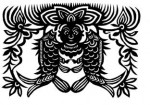 folks on the loess plateau along the Yellow River basin. In the center of the ball is this baby with coiled hair, who is patron saint and god of propagation on loess plateau. Wearing a hair style with double coils upward to the sky, and holding a pair of fish in both arms, she assumes a squatting posture as if giving birth. The lower part of her body is a pair of scissors pointing downward to imply the nature of male or yang, which, corresponding with her hair coils implies that she is hermaphroditic god of the universe. Scissors is yang by nature, a sharp tool that keeps away evil spirits and disasters. As a folk proverb goes: “Awl and scissors drive away the five poisonous creatures.” Some folk art works make the eyes of god as the sun. The two breasts are the two eyes of a cicada, a legendary animal of propagation, to symbolize a continued and never ending posterity. On each side are symbols of “Sheng” (A music instrument, hegemony of “birth” in Chinese), or lotus flowers. “Sheng” is “birth” and lotus is a proliferous symbol with male nature. A local folk proverb goes: “When lotus and sweet osmanthus growing out of a bucket, we have sons, daughters and nephews; when golden cicada blowing ‘Sheng,’ family posterity never ends.” “A ripe persimmon bears eight precious ‘Sheng (kids),’ and a lotus plants the seeds.” In this art work, god of the universe holds yin and yang two fish, one in each hand, with their tails connecting in a continuous letter “Wan” without breaking up, implying a never ending prosperity and continued posterity. In the lower part of the picture are two geometry symbols of Ruyi (good luck), and a legendary rabbit holding grass in the mouth. Rabbit, hegemony of “spit kids”, is god of proliferation. Two rabbits with double Ruyi have the meaning of giving birth to precious sons one after another. A wedding song used by the people of the loess plateau has “double walnuts and double jujubes, double sons and daughters chasing around. A good son is expected to grow up wearing cap and blue gown (to become an official); and a daughter is to be capable with her hands.” With the art of paper-cut, “every cut has a meaning of its own” said the grandmother who made this art work of multi-lateral, collective symbols and cultural codes with the theme of life and propagation. If a paper-cut for window decoration could be a tourist book of northern Shaanxi, “Baby with coiled hair” would be an orchestra of the paper-cut art. It is actually a transformed version of “Double fish with human faces” on 600-year-old painted pottery from the Yangshao culture of Xi’an.
folks on the loess plateau along the Yellow River basin. In the center of the ball is this baby with coiled hair, who is patron saint and god of propagation on loess plateau. Wearing a hair style with double coils upward to the sky, and holding a pair of fish in both arms, she assumes a squatting posture as if giving birth. The lower part of her body is a pair of scissors pointing downward to imply the nature of male or yang, which, corresponding with her hair coils implies that she is hermaphroditic god of the universe. Scissors is yang by nature, a sharp tool that keeps away evil spirits and disasters. As a folk proverb goes: “Awl and scissors drive away the five poisonous creatures.” Some folk art works make the eyes of god as the sun. The two breasts are the two eyes of a cicada, a legendary animal of propagation, to symbolize a continued and never ending posterity. On each side are symbols of “Sheng” (A music instrument, hegemony of “birth” in Chinese), or lotus flowers. “Sheng” is “birth” and lotus is a proliferous symbol with male nature. A local folk proverb goes: “When lotus and sweet osmanthus growing out of a bucket, we have sons, daughters and nephews; when golden cicada blowing ‘Sheng,’ family posterity never ends.” “A ripe persimmon bears eight precious ‘Sheng (kids),’ and a lotus plants the seeds.” In this art work, god of the universe holds yin and yang two fish, one in each hand, with their tails connecting in a continuous letter “Wan” without breaking up, implying a never ending prosperity and continued posterity. In the lower part of the picture are two geometry symbols of Ruyi (good luck), and a legendary rabbit holding grass in the mouth. Rabbit, hegemony of “spit kids”, is god of proliferation. Two rabbits with double Ruyi have the meaning of giving birth to precious sons one after another. A wedding song used by the people of the loess plateau has “double walnuts and double jujubes, double sons and daughters chasing around. A good son is expected to grow up wearing cap and blue gown (to become an official); and a daughter is to be capable with her hands.” With the art of paper-cut, “every cut has a meaning of its own” said the grandmother who made this art work of multi-lateral, collective symbols and cultural codes with the theme of life and propagation. If a paper-cut for window decoration could be a tourist book of northern Shaanxi, “Baby with coiled hair” would be an orchestra of the paper-cut art. It is actually a transformed version of “Double fish with human faces” on 600-year-old painted pottery from the Yangshao culture of Xi’an.
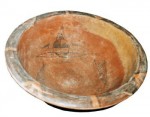 Paper-cut “paired fish dolls” from the loess plateau of Gansu Province has two yin-yang fish one on each side. It shares the same cultural implication and art form as “Yinyang fish,” and “Baby with coiled hair.” In Luochuan, Shaanxi Province, it is in the form of a paired snake with coiled hair, and paired dragon with coiled hair. In Chinese folk art, fish, snake (dragon) and baby girl are related and interchangeable.
Paper-cut “paired fish dolls” from the loess plateau of Gansu Province has two yin-yang fish one on each side. It shares the same cultural implication and art form as “Yinyang fish,” and “Baby with coiled hair.” In Luochuan, Shaanxi Province, it is in the form of a paired snake with coiled hair, and paired dragon with coiled hair. In Chinese folk art, fish, snake (dragon) and baby girl are related and interchangeable.
Paired of fish with human faces on painted pottery from Banpo –In Shaanxi, Shanxi and Gansu area, a similar image as “Baby with coiled hair” is the “Paired fish with human faces” on painted pottery from Yangshao culture of 6000 years ago unearthed in Banpo of Shaanxi. People tend to connect this with the fishing and hunting life style of primitive society. As some argued, the sketches on each side were symbols of a fish net. The painting showed only the heads, the interpretation went on as: two fish nets were set open, and two people were in the water. Their feet being in the water were left out. It was implied that their hands were busy catching fish under the water. By closing in from two opposite sides, they made the fish running into the net. Their half closed eyes were a sub-conscious facial look when focused on catching fish. (Quote from My humble opinion on a few painted potteries. Central China Culture Relics 1987-1). In my opinion, the creators of the art work in primitive society always tried to convey the original Chinese philosophy through cultural symbols and codes that were accepted by the community. Without the knowledge of original Chinese philosophy, it would be impossible to decode their symbols, nor to interpret Chinese archaeology art or folk art. Take fish for example, the paired fish created in the art work was not the fish in their natural being. It was yin-yang fish symbols. The two fish on painted pottery rotating towards opposite direction were yin-yang fish revolving around the sky, a conceptual symbol of perpetual life.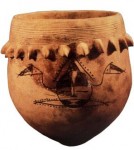
Paired fish with human faces in folk art – Corresponding with paper-cut “Yinyang fish” and “Baby with coiled hair,” “Paired fish with human face” on painted pottery symbolizes the first ancestor, god of the universe. Looking at this image, god has one eye open (from the human face on painted pottery unearthed at Jiang Village), and the other eye closed (from the human face on painted pottery unearthed at Banpo). Apparently, they are not the natural but conceptual eyes. With god of the universe, the open eye is the sun, the day and yang; the closed eye is the moon, the night, and yin. It is common practice in Chinese folk art to liken eye to the sun and the moon. In folk art painting created by the wives in northern Shaanxi, all human faces are round-eyed, same as the eyes of the tiger. Their eye balls are always in the center of the white unsheltered by eye lids. It is believed that a closed eye is the moon and an open eye is the sun. Therefore, eyes should be painted bright and shining. To me, that might also be a cultural comprehension from the primitive clans.